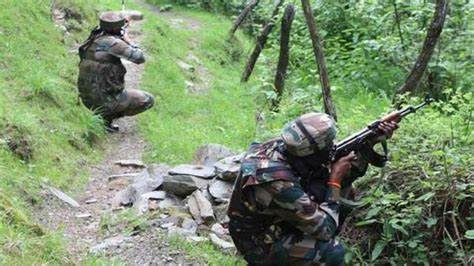Security forces in Arunachal Pradesh shot dead a hardcore cadre of the National Socialist Council of Nagaland (NSCN), a significant insurgent group active in Northeast India. The encounter took place in the early hours in the state’s Tirap district, known for its challenging terrain and dense forests that make it a strategic location for militant activity. The operation highlights the ongoing conflict between insurgent groups and security personnel in the Northeast, where maintaining peace and order remains a complex challenge.
The Encounter: A High-Risk Operation
The operation was conducted by a joint team comprising personnel from the Indian Army, Assam Rifles, and local police forces. Acting on intelligence inputs, the security forces tracked a group of NSCN militants believed to be hiding in the Tirap region. The insurgents were reportedly planning to recruit new members from nearby villages, raise funds through extortion, and strategize new attacks on security installations.
According to official sources, when security forces approached the hideout, the militants opened fire. In the exchange that followed, a high-ranking cadre of the NSCN, who has been identified as a “hardcore” member, was shot dead. Other members of the group managed to escape, aided by the dense jungle, and the security forces are currently combing the area to locate them. The body of the deceased militant was recovered, along with a cache of arms and ammunition, further indicating that the group was prepared for a prolonged confrontation.
Background on the NSCN and Its Role in Northeast Insurgency
The National Socialist Council of Nagaland, particularly factions like NSCN-IM (Isak-Muivah) and NSCN-K (Khaplang), have been prominent players in the insurgency landscape of Northeast India. Formed in 1980, the NSCN aims to establish a sovereign Nagaland, called “Nagalim,” encompassing areas inhabited by the Naga ethnic group across multiple states, including Nagaland, Manipur, Assam, Arunachal Pradesh, and even parts of Myanmar. Their demand for a separate Naga state has led to violent clashes, both with security forces and other insurgent factions operating in the region.
Despite several peace talks over the years, the NSCN’s splinter groups have continued their activities, often engaging in violent skirmishes, extortion, and recruitment drives to sustain their ranks. These insurgent groups exploit the Northeast’s difficult terrain and porous international borders, which provide easy movement between India and Myanmar, complicating the efforts of security forces to maintain peace.
Strategic Importance of the Tirap Region
Tirap, along with the neighboring districts of Changlang and Longding in Arunachal Pradesh, has long been a hotspot for insurgent activities. Its proximity to Myanmar makes it a prime location for insurgent groups who seek refuge and access to cross-border supplies. The area is densely forested and sparsely populated, allowing militants to establish hideouts and move freely between Indian territory and their bases across the border.
In recent years, the Indian government has increased security measures and coordinated with Myanmar’s military to combat insurgent activities along the border. However, maintaining control in these remote regions remains a challenge. Local residents are often caught in the crossfire, with the region’s youth vulnerable to recruitment by militant groups who exploit economic hardships and lack of employment opportunities.
Implications for Regional Security
The recent operation in Tirap, though successful in neutralizing a key NSCN operative, underscores the volatile security situation in the Northeast. While incidents of violence have declined compared to previous decades, the presence of armed insurgent groups remains a persistent threat. Their influence hampers the region’s development and impacts local communities, who face extortion and threats from these groups.
The Indian government’s approach to dealing with these insurgencies involves both military action and peace talks. The government has been engaged in a prolonged dialogue with NSCN factions, notably with NSCN-IM, to find a political solution to the Naga issue. However, peace negotiations with the NSCN-K have been less successful, with the faction rejecting the framework of the peace talks and choosing to continue its insurgency.
Despite these efforts, there are fears that unresolved issues may drive more youth towards militancy, prolonging the cycle of violence. The government and security forces are also concerned about the influence of external factors, including support for insurgent groups from across the Myanmar border. The existence of safe havens for these groups outside Indian territory complicates counterinsurgency measures.
Local Impact and Response
For the residents of Tirap and neighboring districts, the recent encounter brings mixed emotions. While the elimination of a hardcore insurgent is seen as a step toward safer communities, the constant presence of security operations has disrupted daily life. Local communities face an environment where the threat of violence and reprisals from both insurgents and security personnel are a reality.
The state government, along with local security forces, has been trying to engage with communities through development initiatives and employment programs to reduce insurgent recruitment. These programs aim to provide alternative livelihoods and reduce the appeal of joining militant groups. However, local leaders and analysts believe that sustainable peace can only be achieved through comprehensive solutions that address the root causes of insurgency.
The killing of an NSCN cadre in Tirap reflects the ongoing battle against insurgency in Arunachal Pradesh and the broader Northeast region. As security forces continue to tackle insurgent threats, the region remains a focal point of India’s counterinsurgency efforts. While such operations provide short-term victories, achieving long-term peace requires a delicate balance of military action, diplomacy, and socioeconomic development. With local and national authorities working to stabilize the area, the hope remains that the Northeast can eventually move past its insurgency-laden history toward a more peaceful and prosperous future.



